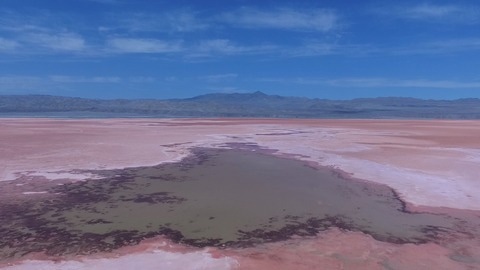A recent study led by Daniel Corkran, a graduate student at the University of Massachusetts Amherst, reveals the hitherto unidentified physical mechanisms that govern sustainable water usage. Previous research from the University of Massachusetts Amherst has demonstrated that commonly accepted figures quantifying how much water can be withdrawn from salares overestimate the amount of water available by more than an order of magnitude. Additionally, it challenges several commonly held notions about what constitutes sustainable lithium mining.
 Much of the world’s lithium deposits are contained in hyperarid salars, like this one, Salar de Atacama in Chile. Image Credit: David Boutt
Much of the world’s lithium deposits are contained in hyperarid salars, like this one, Salar de Atacama in Chile. Image Credit: David Boutt
One of the most significant impediments to achieving a low-carbon energy future is the rare-earth element lithium, which is a vital component of batteries capable of storing copious and sustainable renewable energy.
The element occurs naturally as a salt in briny oases known as salares in some of the harshest settings on the planet, including the “Lithium Triangle” in South America’s dry Altiplano region. Mining lithium has the potential to destabilize already fragile ecosystems that support uncommon flora and fauna, as well as the Indigenous cultures that have long lived there.
It is all about the location and water density.
The question that really drove this study centers around a debate between two different parties in these arid basins. Some view the types of water available in these basins— fresh, brackish, and lithium-containing salt water (brine)—as one continuous water resource, meaning that when lithium companies pump enormous amounts of brine out of the salares, they’re using an enormous amount of water.
Daniel Corkran, Study Lead, University of Massachusetts Amherst
Corkran added, “They claim that this usage will greatly affect all the other water demands, both environmental and human, to which that water could be put. On the other hand, lithium companies have pointed out that the brine is 200 times saltier than seawater and so can’t support life. Therefore, it’s only the fresh water in these salares that matters, and since lithium doesn’t occur in the freshwater portions of the salares, there’s nothing to worry about. Given the wide gulf between the two conceptualizations and the implications for sustainable water use, we decided to test both hypotheses.”
Corkran and his co-authors, who include members of David Boutt's Hydrogeology Group at UMass Amherst and collaborators from the University of Alaska Fairbanks and the University of Dayton, began by designing a series of extremely complex model simulations to project the outcomes of lithium and freshwater pumping over the next 200 years across a wide range of climactic scenarios and geological settings.
They then compared their modeled results to satellite data from salares in two distinct parts of the Lithium Triangle, which supplies more than half of the world’s lithium deposits. Each of these salares uses a distinct kind of lithium mining: the standard evaporative process, which includes evaporating brine, and direct lithium extraction, or DLE, which maintains the brine while using up to 200 % more freshwater.
Corkran’s systematic evaluations revealed two new processes.
David Boutt, Study Senior Author and Professor, Earth, Geographic, and Climate Sciences, University of Massachusetts Amherst
The first concerns the location of the water pumps used by the salar mining businesses. According to the conventional view of the connection between water and sustainability, one can only use as much water as comes in responsibly, and it is preferable to utilize the fresh water rather than the older water that is kept in the aquifer.
However, salares are made up of both briny and freshwater sections, with a transitional zone between the two. Corkran discovered that the closer a company pumps to the fresh water, the more it affects the salar’s wetlands and the quicker its shores recede. The freshwater portions are found near the basin’s edge, close to the locations where fresh groundwater replenishes the wetlands.
“The fresh water is what we shouldn’t be touching,” stated Boutt, who added that both local agriculture and enterprises that mine for other precious metals, such as copper, as well as the newer DLE ways of extracting lithium, may be having an outsized influence on the salares.
Corkran added, “Instead, companies should be pumping water from the briniest patches they can find.”
Consider what happens to water when it freezes. Fill a glass jar with fresh tap water, seal it securely, and freeze overnight. Since freshwater is denser than ice, when one checks on it in the morning, the jar will have cracked. As the water froze, it expanded, increasing volume, reducing density, and shattering the jar despite the fact that the number of water molecules remained constant.
Something similar occurs in the salares.
Saltwater is denser than freshwater. Pound for pound, it occupies less room in the salar. This implies that when mining firms pump out thick, low-volume salt water, the impact on water levels is reduced. However, pumping out less dense, high-volume fresh water has a greater influence on water levels.
In other words, pumping out additional salt water has no effect; yet, pumping out fresh water causes the salar's groundwater-dependent wetlands to disappear.
Corkran and colleagues validated this finding by measuring two wetlands in separate salares: the Diffuse South Tumisa Discharge Zone in Salar de Atacama and the Rio Trapiche Vega in Salar del Hombre Muerto.
“What this all adds up to is that we don’t have to be all that concerned about pumping brine. But we need to be very careful with any freshwater usage—whether for mining, agriculture, or any other use. And if we do decide to go full steam ahead with DLE technology for lithium, we need to address its needs for fresh water,” added Boutt.